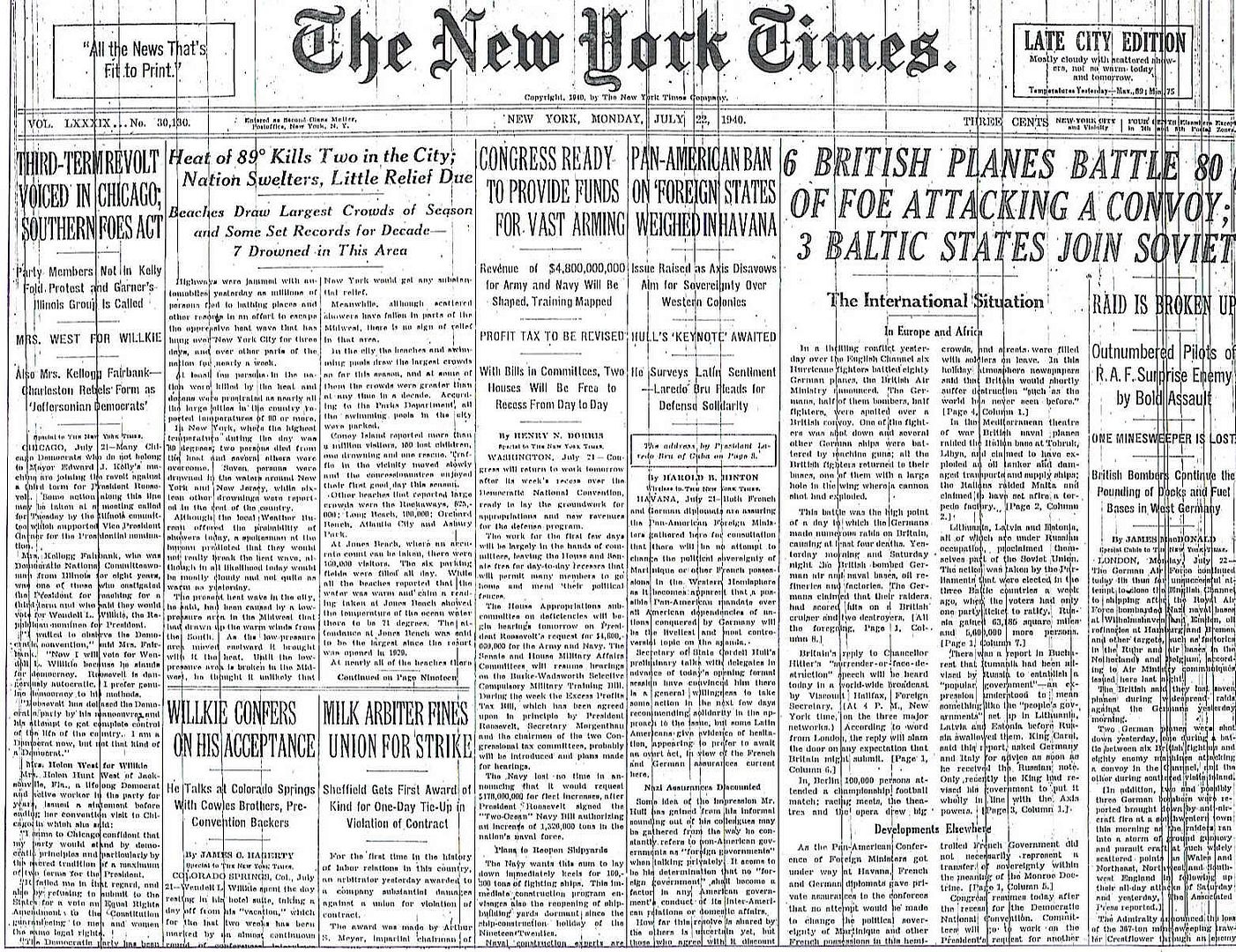
Posted on 07/22/2010 6:00:43 AM PDT by Homer_J_Simpson

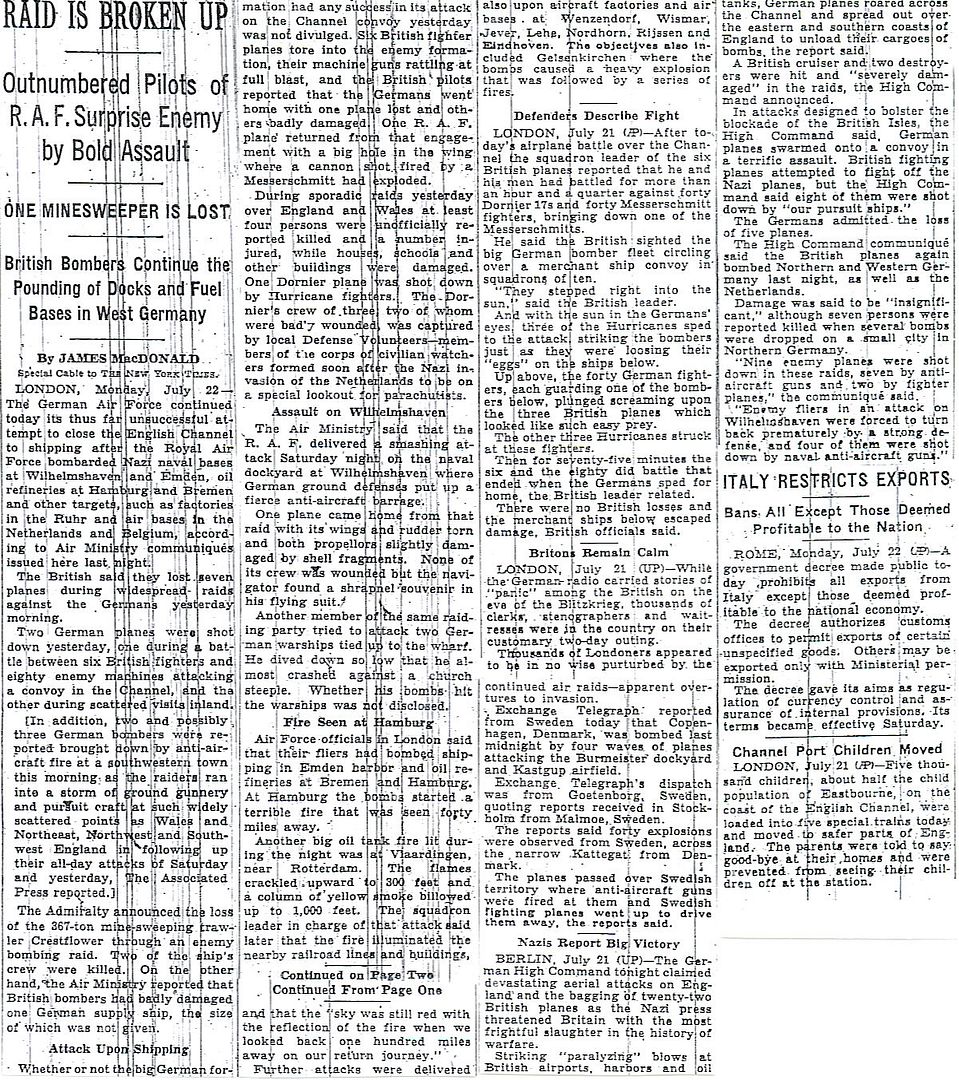
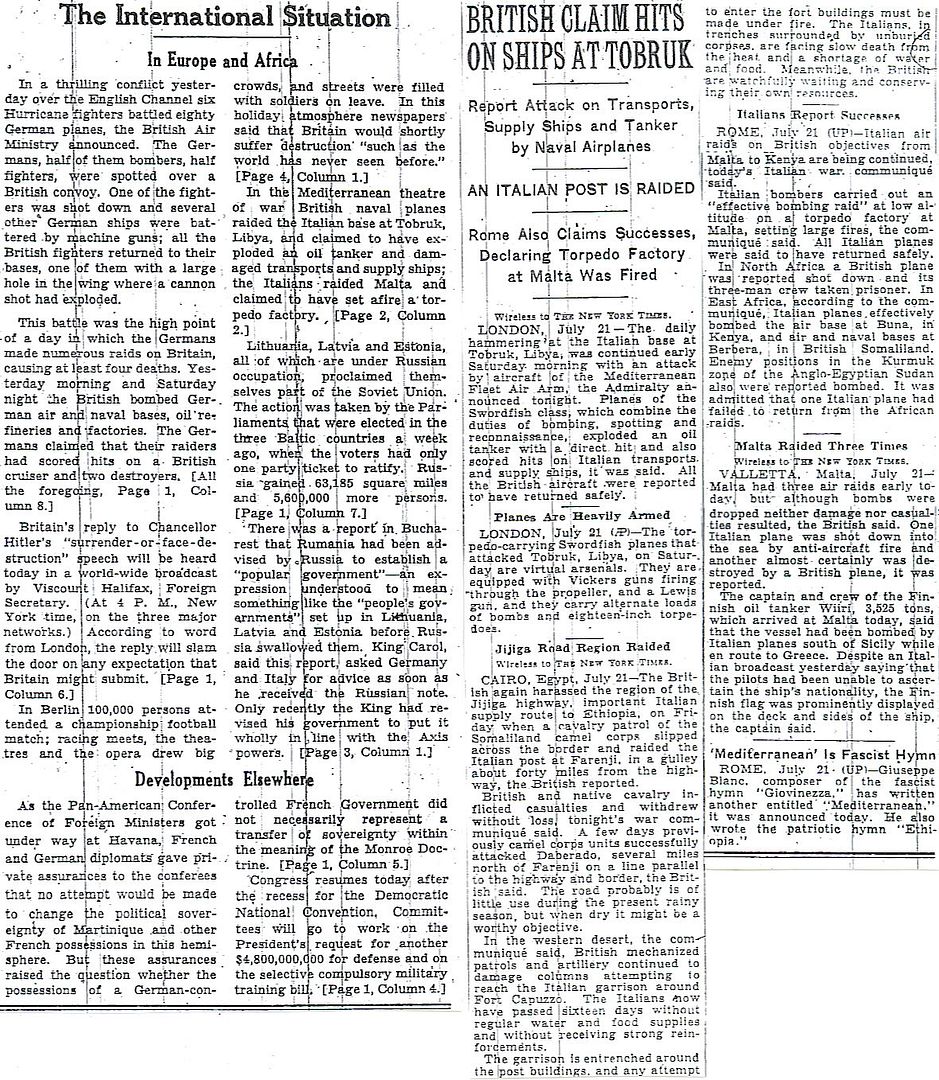
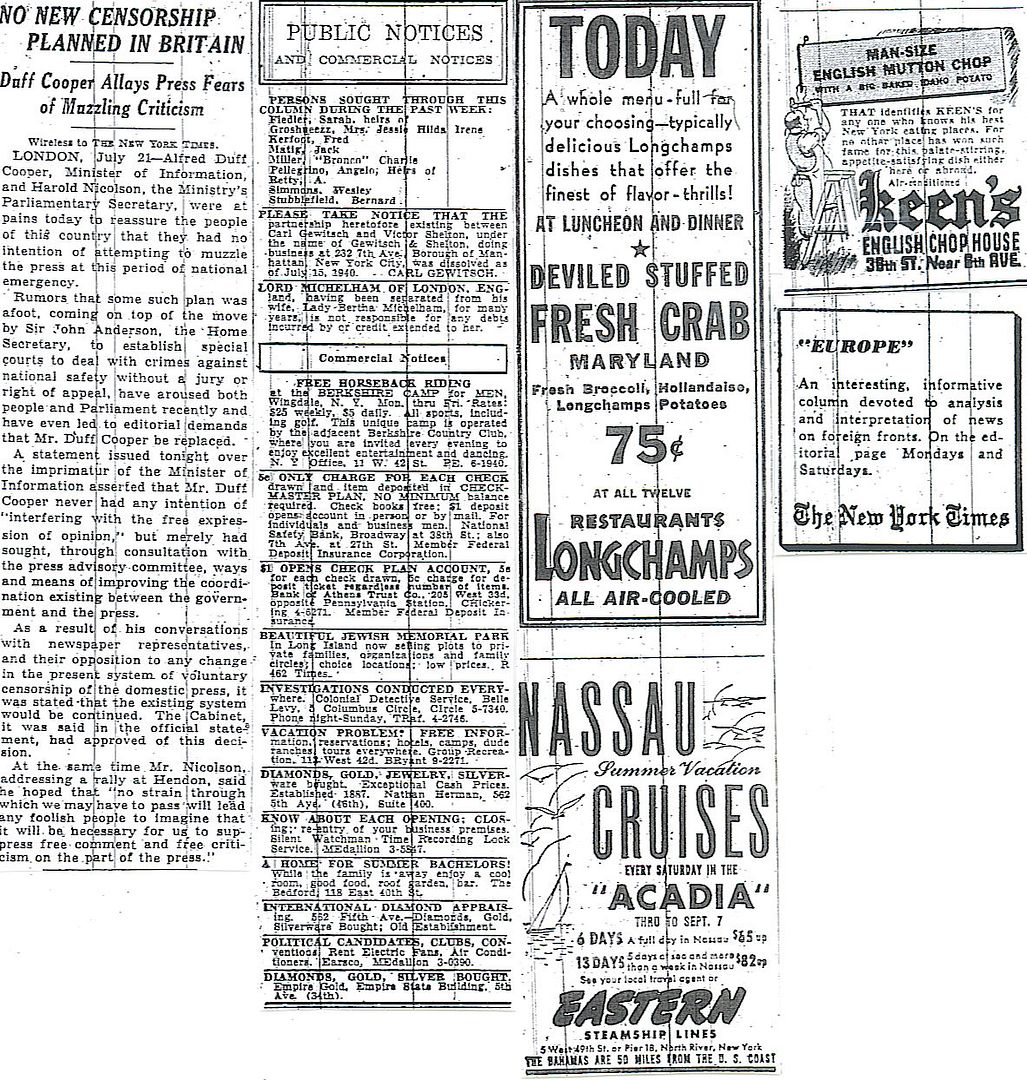
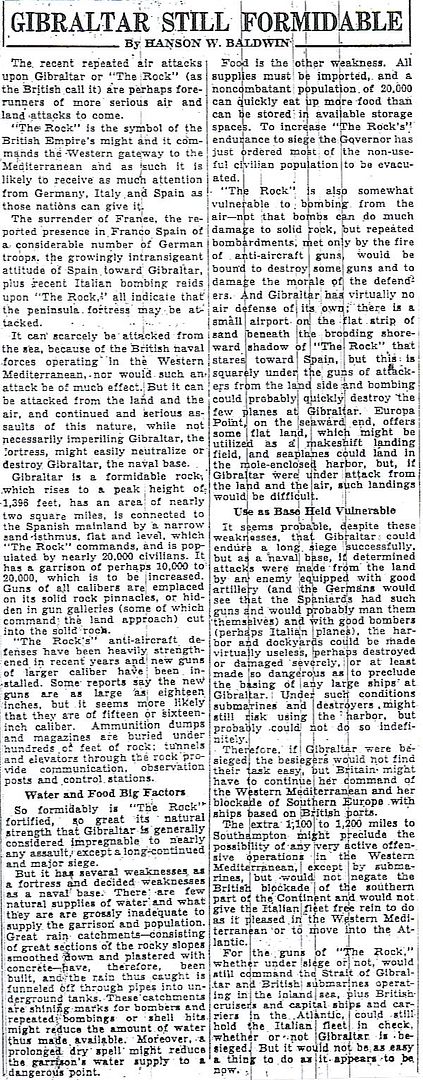
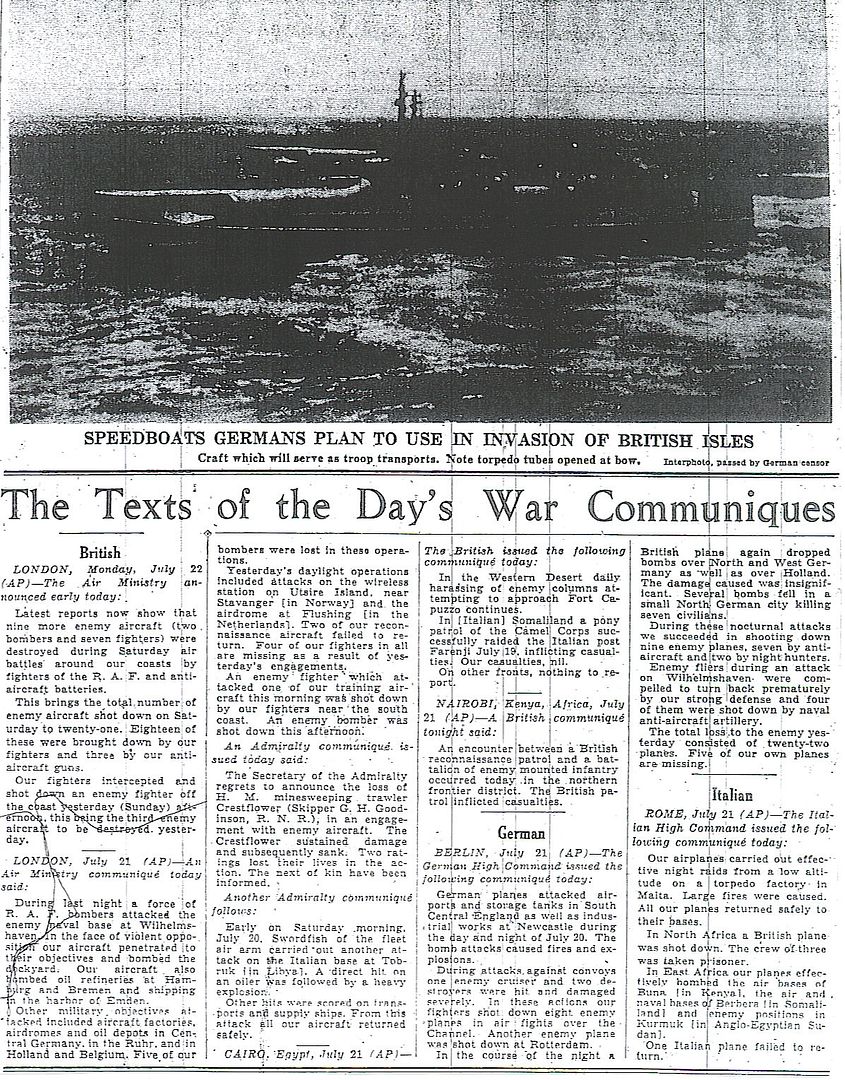
* Oh,oh – new place name. Better get out the atlas.
** I kept this even though you can’t actually make out the alleged speedboats. Just the idea that the invasion is so taken for granted makes it interesting. - Homer
http://www.onwar.com/chrono/1940/jul40/f22jul40.htm
British support resistance to Nazis
Monday, July 22, 1940 www.onwar.com
In Britain... The British government believes strongly that there will be uprisings against Hitler’s rule that will contribute greatly to the overthrow of his power and will make a British return to the continent possible. The Special Operations Executive is created to work clandestinely to encourage these developments. Although events will not turn out as the British imagine, SOE will make a considerable contribution to the development of the various resistance movements in occupied Europe. Officially SOE is to be part of the Ministry for Economic Warfare.
In London... The British Foreign Secretary, Lord Halifax, replies to Hitler’s “appeal to common sense” of July 19th with “we shall not stop fighting till freedom for ourselves and others is secure.”
Date: 22 July 1940

________________________________________
Enemy action by day
Enemy activity by day was on a considerably reduced scale. Just prior to the opening of the period covered by this summary, two convoys were attacked by enemy aircraft off the East Coast. One of these attacks was referred to in the previous summary (21st July) but it is now reported that fighters intercepted and claim one Do17 as a probable casualty.
Thereafter some 14 raids were detected. These appear to have been mainly engaged in meteorological and shipping reconnaissance flights off the East and South coast; although convoys were approached, no resultant attacks were reported. Convoy and shipping protection patrols were flown by our fighters and possibly accounted for the apparent reluctance on the part of the enemy to attack by daylight. A few raids crossed our coasts; one was plotted between Bristol and the Sussex coast, flying very high. Another Do17 crossed the coast near Selsey Bill and was intercepted and shot down off Tangmere. A raid of three aircraft was plotted 10 miles off Selsey Bill and appeared to have been intercepted but no combat reports have been received.
France
A number of hostile raids were plotted in the Calais - Boulogne - Dunkirk - St Omer areas and several raids went from Cherbourg to mid-Channel in the late evening, but these faded and nothing more was heard of them.
By night
Considerable enemy activity again took place over a wide area. Shortly after 2100 hours, raids commencing down Channel from the Boulogne/Calais area turned north, north of Cherbourg towards Portland and Land's End, minelaying being suspected, and some crossing the coast. From 2200 hours until about 0200 hours, a number of raids approached the North-East, East and South-East Coasts. Another group, presumably from Norway, attacked objectives in Scotland. Minelaying throughout the whole of the East coast is suspected, particularly in the Thames Estuary, and to a lesser extent, in the Tees, off the Norfolk coast, Humber and Tyne areas. A number of raids came inland and bombs were reported to have been dropped in the following districts:- Thames Estuary, North Kent, near Manston, South Essex, Norfolk, Kidderminster, Welshpool, Brough, Edinburgh, near Drem and South Wales. At about 2347 hours, it is reported that a Do 17 was shot down off Selsey Bill. No reports of serious damage or casualties have been received.

________________________________________
Statistics
Fighter Command Serviceable Aircraft as at 0900 hours, 22 July 1940
Casualties:
Patrols:
Balloons:
Aerodromes:
Organisation:
Air Intelligence Reports
Home Security Reports
I am reading a great book by author Ed Macy, retired British Apache Helicopter pilot as he talks about his time in Afghanistan.
Apache: Inside the Cockpit of the World’s Most Deadly Fighting Machine
By Ed Macy
http://homepage.ntlworld.com/andrew.etherington/month/thismonth/22.htm
July 22nd, 1940
UNITED KINGDOM: RAF Bomber Command: 4 Group (Whitley). Bombing - aircraft factory at Bremen and industrial targets Ruhr.
10 Sqn. Eight aircraft to Bremen. All bombed.
51 Sqn. Seven aircraft to the Ruhr. Three bombed.
58 Sqn. Eight aircraft to Bremen. Two returned early, two bombed primary, three bombed alternative targets. One FTR.
2 Group ( Blenheim). 107 Sqn. Bombing - Creil - started a fire visible 40 miles away.
RAF Fighter Command: The first victory by a Blenheim Mark 1F night fighter, equipped with airborne radar.
London: The war cabinet today approved a draft document signed 19 July by Neville Chamberlain, now the Lord President of the Council, creating a new secret organisation, the Special Operations Executive (SOE). It’s aim, in Churchill’s words, is to “set Europe alight.”
It will come under the Labour MP Hugh Dalton, the Minister for Economic Warfare in the coalition government, who was asked to head the planned SOE on 16 July. Both MI6, which has its own sabotage department and the army have expressed opposition to the formation of SOE because it intrudes into their territory, but Dalton is determined it will succeed.
“Regular soldiers,” he argues, “are not the men to stir up revolution, to create social chaos or to use all those un-gentlemanly means of winning the war which come so easily to the Nazis.”
Destroyer HMS Beagle destroyed a German Junkers JU-87 by pom-pom fire.
Destroyer HMS Brazen: loss of the ship reported. She was sunk while returning under tow, to port, after being attacked by enemy aircraft. Three planes were reported shot down. All the ship’s crew was saved.
Destroyer HMS Paladin laid down.
Minesweepers HMS Lantan and Lyemun laid down. (Dave Shirlaw)
U.S.S.R.: Soviet submarine SC-138 launched. (Dave Shirlaw)
JAPAN: Tokyo: Prince Fumimaro Konoye is appointed prime minister.
CANADA: Corvette HMS Eyebright launched Montreal, Province of Quebec. (Dave Shirlaw)
Day 326 July 22, 1940
Battle of Britain Day 13. Luftwaffe flies only reconnaissance missions and no convoys are attacked, despite good flying weather. Hurricanes of 145 Squadron shoot down a lone Dornier Do17 bomber off Selsey Bill. A Hurricane of 85 Squadron crashes approaching Castle Camps airfield killing the pilot. Overnight, numerous small German raids bomb coastal towns or lay mines off the East coast of England and Scotland (another Do17 is shot down).
British Foreign Minister Lord Halifax broadcasts a speech rebutting Hitler’s offer of peace in his Reichstag speech of July 19. “No one here wants the war to go on for a day longer than is necessary. But we shall not stop fighting until freedom, for ourselves and others, is secure.”
In Japan, General Hideki Tōjō is appointed Army Minister in Prime Minister Fumimaro Konoe’s new cabinet.
British submarine HMS Clyde fires 6 torpedoes at another British submarine HMS Truant, off Fejeosen, Norway. Fortunately, all torpedoes miss and neither sub is damaged.
Planes Are Heavily Armed
Lond, July 21 (AP)-The torpedo carrying Swordfish planes that attacked Tobruk Libya on Saturday are virtual arsenals. They are equipped with Vickers guns firing through the propeller and Lewis guns and they carry alternate loads of bombs and eighteen inch torpedoes.
The Swordfish (aka “Stringbag”) was a bi-plane torpedo bomber with a single Lewis (light machine gun) in the rear cockpit, and a single Vickers gun firing forward. It was slow (to put it mildly) and achieved success primarly due to surprise (nobody but the Brits had radar) and the skill and courage it its crews.
Compare this to, say, a Hurricane which eight or even twelve Vickers, or a Wellington, which had a quad turret aft, a twin turret forward and couple of guns in the waist. The Swordfish was a lightly armed flying target the sort of which fighter pilots dream. When they actually ran into fighter opposition, they were slaughtered as in the Channel Dash (Operation Cerberus).
Then, as now, AP didn't have clue.
Interesting to note the Brits also had problems with their torpedoes, or subs, or both -- fortunately, in this unusual case.
At least these torpedoes did not circle around to sink the sub which launched them!
By war's end the Brits will not only learn to tell friend from foe, but we have the famous example of a submerged British sub, HMS Venturer, sinking a submerged German sub, U-864, at long distance.
There was a very good show on the last voyage of the U-864 on the Military Channel a few weeks back. Can’t remember the name of it now.
Thanks for the Ping, Homer! :)
Disclaimer: Opinions posted on Free Republic are those of the individual posters and do not necessarily represent the opinion of Free Republic or its management. All materials posted herein are protected by copyright law and the exemption for fair use of copyrighted works.